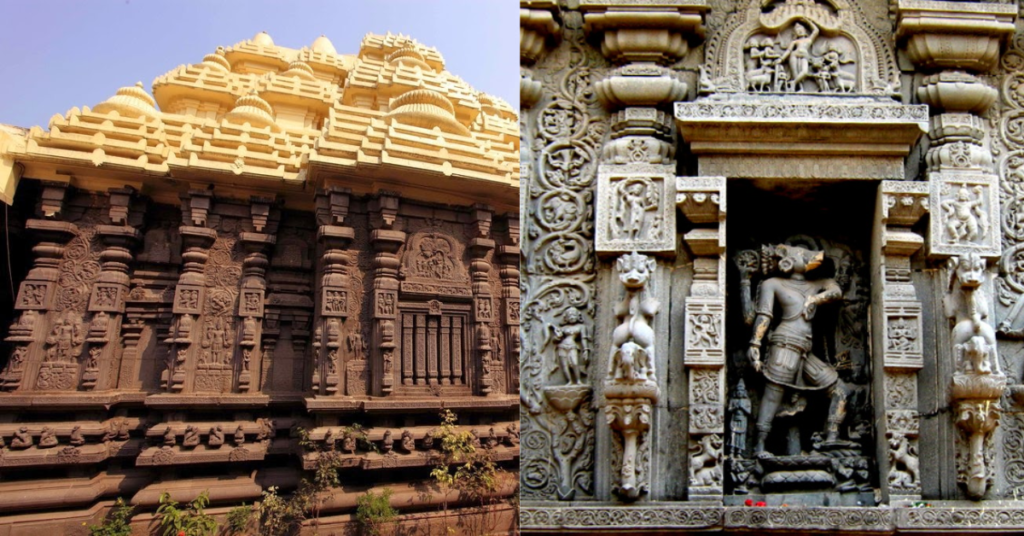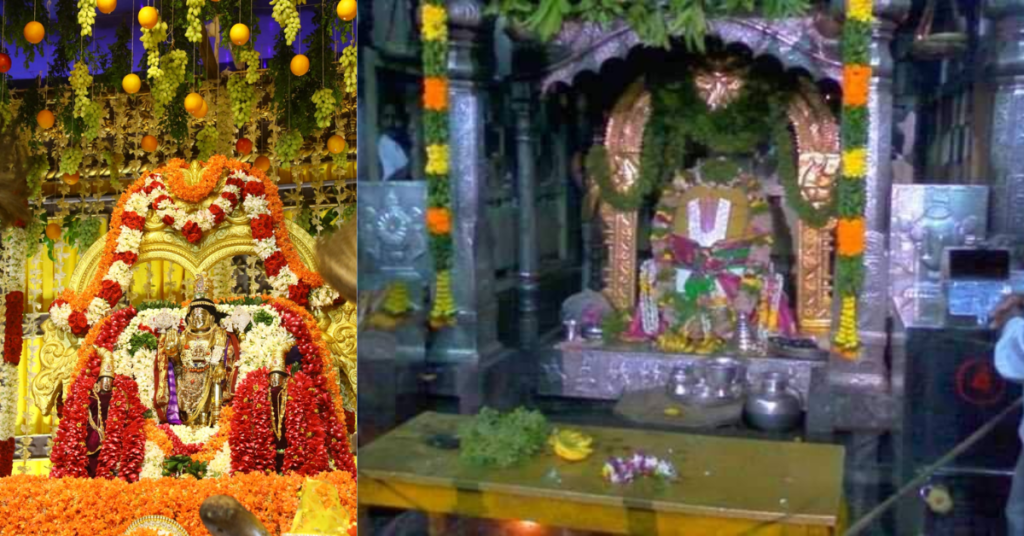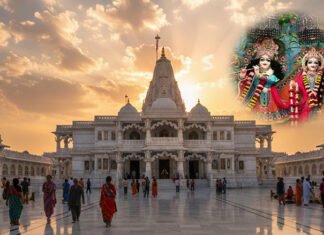Introduction
Welcome to our exploration of the Simhachalam Temple, a sacred site nestled in the hills of Visakhapatnam, Andhra Pradesh. This ancient Hindu temple, dedicated to Lord Vishnu in his Varaha Narasimha form, is not only a spiritual haven but also an architectural marvel. Perched 300 meters above sea level, Simhachalam Temple is renowned for its unique blend of mythology, history, and vibrant festivals. From its legendary origins to its grand festivals, this temple offers a rich tapestry of cultural and religious significance. Join us as we delve into the fascinating world of Simhachalam Temple and uncover what makes it a treasured destination for devotees and history enthusiasts alike.

History of Simhachalam Temple
Simhachalam Temple has a rich history dating back to ancient times, with its earliest inscriptions found from the 11th century CE. The temple as it stands today was constructed by the Eastern Ganga king Narasingha Deva I in the 13th century and consecrated by his son, Bhanudeva I, in 1268 CE. Over the centuries, the temple has seen patronage from various dynasties. Including the Eastern Gangas, the Suryavamshi Gajapati Dynasty of Odisha, and the Tuluva Dynasty of the Vijayanagara Empire. The temple’s history is also marked by a period of decline, lasting 40 years, from 1564 to 1604 CE. However, it was revitalized and continues to be an important pilgrimage site today.

Legends Associated with the Temple
Simhachalam Temple is steeped in mythology, primarily connected to the story of Lord Vishnu’s Narasimha avatar. According to the legend, Vishnu manifested as Varaha Narasimha, a form combining a boar (Varaha) and a lion (Narasimha), to save his devotee, Prahlada, from his demon father, Hiranyakashipu. The story goes that after killing Hiranyakashipu, Narasimha’s anger was uncontrollable, and it was only when Prahlada prayed to him that he calmed down. The temple is believed to have been built at the exact spot where this event took place, making it a sacred site for devotees.
Also Read: Ultimate Guide to Exploring Rushikonda Beach in Andhra Pradesh in 2024
Architecture of Simhachalam Temple
The Simhachalam Temple resembles a fortress with three outer courtyards (prakarams) and five gateways. The current structure was largely rebuilt by Narasimhadeva I and combines architectural styles from the Eastern Gangas, Eastern Chalukyas, and Cholas. The temple unusually faces west, which, according to Hindu texts like the Purushottama Samhita and Vishnu Samhita, symbolizes victory. The temple’s five-tier rajagopuram (main tower) is located on the western gateway. Devotees enter through a side door that leads to the Kalyana Mandapa (wedding hall) with its 96 pillars, featuring carvings of Vishnu, Lakshmi, and the Alvars. The temple’s vimana (tower) has a three-tiered pyramid shape, capped with a gold-plated dome. The walls of the sanctum sanctorum display sculptures in the Kalinga style, including scenes from Hindu mythology like Narasimha’s victory over Hiranyakashipu and Varaha’s rescue of the Earth.

The temple also has special halls for events and a dance hall with lion-head carvings at the base of its pillars. The outer parapet wall (jagatti) features rows of sculpted elephants, while the inner one has swan carvings. The Kalyana Mandapa’s pillars are adorned with the 32 forms of Narasimha, including the temple’s presiding deity.
Simhachalam Temple Geographic Information

The Simhachalam Temple is located on the Simhachalam Hill Range, about 800 meters (2,600 feet) above sea level and 10 miles north of Visakhapatnam. Part of the Eastern Ghats, the hill range is called Kailasa and features the temple at the top, nestled within an amphitheater-like setting. The temple’s height is approximately 1,500 meters (4,900 feet) above sea level, and a natural valley runs along the northwest slope. Over time, the hill’s terraces have been used to cultivate crops like pineapples, jackfruit, and bananas, and a small village has developed around the temple. Steps were built alongside a stream to provide access to both the village and the temple.

The area’s soil, climate, and rainfall contribute to lush vegetation, and the hills are rich in medicinal herbs used for treating both human and animal ailments. The most popular route to the temple involves climbing a thousand steps from the base, starting at the Bhairava Dwaram entrance. Another path leads from the Madhava Dwaram to the top. Roads also have been constructed from Bhairava Dwaram to the summit. The temple has two water tanks: the Swami Pushkarini at the top and the Gangadhara, also known as Varaha Pushkarini, at the base. Three natural springs—Akashadhara, Chakradhara, and Madhavadhara—are also located on the hill. Gardens at the base host festivals throughout the year.
Also Read: Exclusive Dolphin’s Nose Lighthouse beauty of Visakhapatnam
Main Shrines of the Temple
The main deity, Varaha Narasimha, is housed in a separate hall called the Prahlada Mandapa. The idol is around 2.5 feet tall, depicting the deity with a boar’s head, human torso, and lion’s tail, accompanied by the goddesses Sridevi and Bhudevi. Due to vandalism, the idol’s original features are damaged, and it is covered with sandalwood paste, making it resemble a Shiva Lingam. The temple’s ornaments include a diamond-and-ruby Thirunamam, an emerald necklace, a gold bracelet, and a crown.
The complex also contains sub-shrines dedicated to Andal, Lakshmi (Simhavalli Thayar), and the Alvars. There are also smaller temples for Tripurantaka (the guardian deity), Bhairava, and Rama, as well as Anjaneya and Kasi Vishweswara, near the Gangadhara spring.
Festivals at Simhachalam Temple

Important Festivals
- Kalyanotsava: This is a significant festival that celebrates the divine marriage of Lord Varaha Lakshmi Narasimha. It typically involves elaborate rituals and processions.
- Chandanotsava: Celebrated in May, this festival involves applying sandalwood paste to the deity, symbolizing purification and devotion. It is a major event that draws many devotees.
- Narasimha Jayanti: Marked to honor the incarnation of Lord Narasimha, this festival is observed with special prayers, rituals, and festivities.
- Navaratrotsava: This festival, held during Navaratri, includes nine nights of worship dedicated to the divine feminine, with special rituals and processions.
- Kamadahana: This festival is dedicated to the deity’s role in removing obstacles and granting wishes. It includes special prayers and rituals.
Other Festivals
- Krishna Janmashtami: Celebrates the birth of Lord Krishna with prayers, dances, and songs.
- Karthika Deepavali: A festival of lights observed in the Karthika month, featuring lighting of lamps and special prayers.
- Giripradakshina: Involves circumambulating the hills surrounding the temple, symbolizing devotion and reverence.
Minor Festivals
- Sankranti: Celebrated in January, marking the harvest season with special offerings and prayers.
- Holi: The festival of colors is observed with vibrant celebrations and rituals.
- Deepavali: Known as the festival of lights, it involves lighting lamps and offering prayers to deities.
- Ugadi: The Telugu New Year, celebrated with special prayers, rituals, and festive meals.
Entry Fee and Timings
- Entry Fee: There is no general entry fee to visit the Simhachalam Temple. However, a special darshan option is available for INR 100 per person.
- Timings:
- Morning: 7:00 AM to 4:00 PM
- Evening: 6:00 PM to 9:00 PM
Things to Do Around Simhachalam Temple
After exploring the Simhachalam Temple, you can visit these top tourist spots in Visakhapatnam:
- Indira Gandhi Zoological Park
Distance: 14.5 km
Highlights: Nestled in the Eastern Ghats, this park houses over 80 species of animals, including carnivores, mammals, primates, and ungulates. It also features a dedicated zone for moths and butterflies. - Kambalakonda Wildlife Sanctuary
Distance: 14.6 km
Highlights: Ideal for adventure seekers and bird watchers, this sanctuary offers a thrilling trek through dense jungle and lush green gorges. - Kailasagiri
Distance: 15.2 km
Highlights: This park provides stunning views of the Bay of Bengal. It’s a great spot for solo travelers, couples, and families to enjoy panoramic views and a relaxed environment. - VUDA Park
Distance: 16.1 km
Highlights: Located adjacent to RK Beach, this park is perfect for morning and evening walks, featuring over 2,500 trees, colorful plants, and vibrant flowers. - Visakhapatnam Aquarium
Distance: 17.7 km
Highlights: Established in 1994, this air-conditioned aquarium showcases a variety of marine species, including Red Squirrel Fish, Lionfish, and Butterfly Fish, with some species imported from Singapore and Malaysia.
How to Reach Simhachalam Temple
By Air: Fly into Visakhapatnam Airport from major cities like Mumbai, Hyderabad, Chennai, and Delhi. International flights to Singapore, Dubai, and Kuala Lumpur are also available.
By Train: Arrive at Visakhapatnam Railway Station and take Bus 6A or a taxi to the temple. The station is well-connected to other cities.
By Bus: From Dwarka Bus Stand, you can take Bus 6A or 40 to the temple. Buses 55 and 540 are available from Gajuwaka and Maddilipalem respectively.
For a smooth trip, consider booking a tour package through Vizag Tourism.
Conclusion
Simhachalam Temple stands as a beacon of spirituality and historical grandeur, offering a unique blend of mythological richness, architectural beauty, and vibrant festivals. Its significance as a sacred site dedicated to Lord Vishnu’s Varaha Narasimha form makes it a cherished destination for devotees and history enthusiasts alike. With its stunning hilltop location, intricate carvings, and lively festivals, the Simhachalam Temple invites visitors to explore not just a place of worship but a testament to the rich cultural heritage of Andhra Pradesh.
A: The main deity is Varaha Narasimha, a form of Lord Vishnu.
A: Morning: 7:00 AM to 4:00 PM, Evening: 6:00 PM to 9:00 PM.
A: The temple was constructed in the 13th century CE by Eastern Ganga king Narasingha Deva I.
A: The temple is accessible by air, train, and bus from Visakhapatnam.
A: Yes, nearby attractions include Indira Gandhi Zoological Park, Kailasagiri, and VUDA Park.











